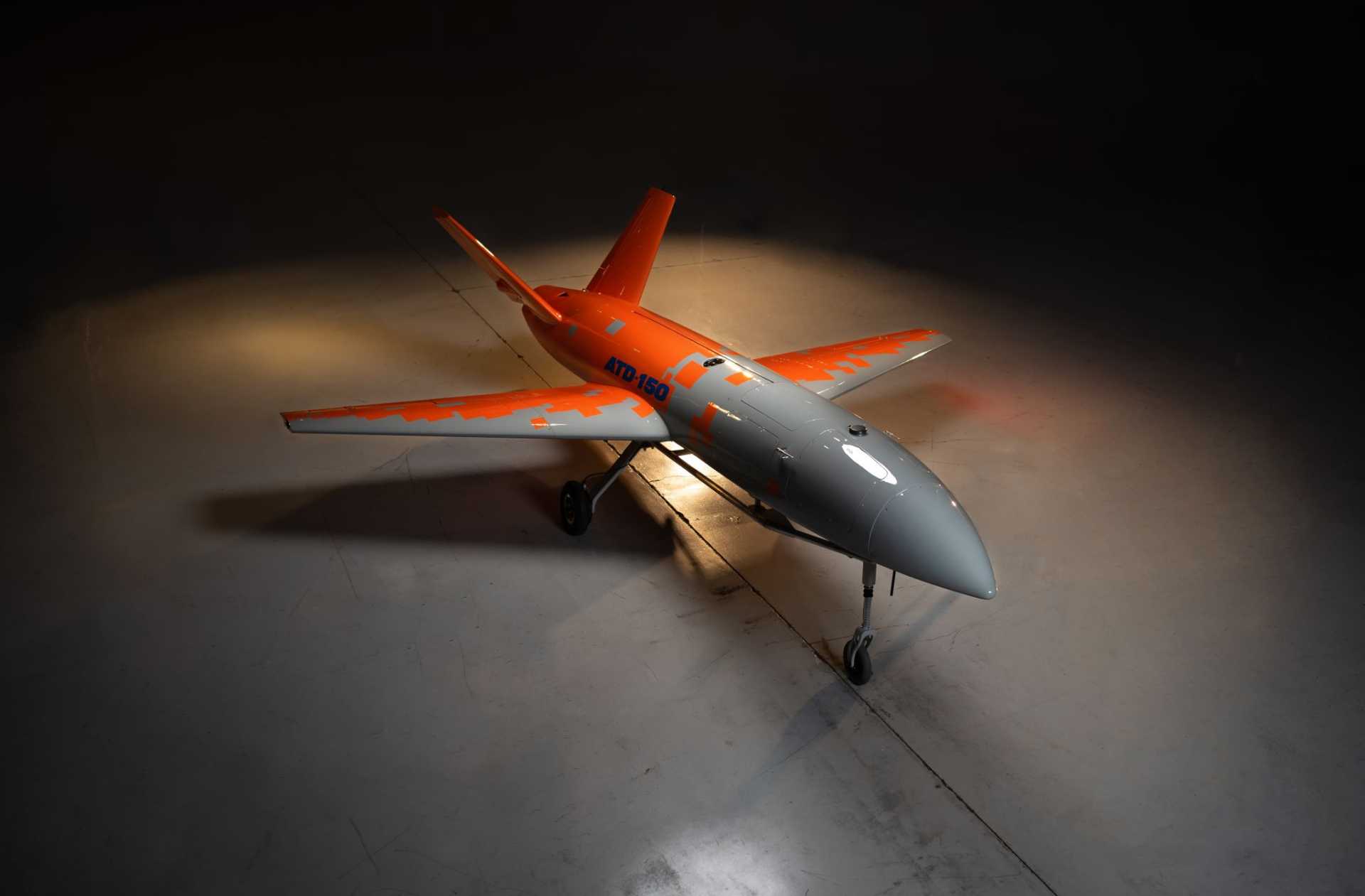Brazil strengthens strategic autonomy with first fully indigenous jet-powered drone ATD-150

{loadposition bannertop}
{loadposition sidebarpub}
On March 29, 2025, the Brazilian company Nest Design Aerospace presented the ATD-150, described as the country’s first 100% indigenously designed jet-powered unmanned aircraft. The system has been developed specifically to serve as an aerial target for the Brazilian Armed Forces and is also being considered for export to international users. According to the manufacturer, the ATD-150 is intended to replicate advanced aerial threats in training environments and aims to enhance operational readiness by providing a domestic solution for simulated combat exercises and system testing.Follow Army Recognition on Google News at this link
The ATD-150 integrates a Miss Distance Indicator (MDI) for recording the proximity of intercept attempts, and features passive RF signal augmentation, real-time video transmission capability, and an infrared (IR) signature. (Picture source: Nest Design Aerospace)
According to available information, the ATD-150 has a maximum takeoff weight (MTOW) of up to 150 kilograms and a maximum payload capacity of 15 kilograms. It can operate at altitudes between 10,000 and 15,000 feet, with a service ceiling of 20,000 feet. Under flight conditions of FL150 and ISA+35, it achieves a cruise speed of Mach 0.6. The propulsion system is the TM TJ-200 turbojet engine, developed in Brazil by Turbomachine. The UAV runs on Jet A-1 or aviation kerosene. Nest Design Aerospace states that this configuration enables the ATD-150 to function as a high-speed, jet-powered target suitable for complex and realistic threat simulations during training operations and air defense exercises.
The main mission profile of the ATD-150 includes applications such as air strike training, air-to-air engagement training, air defense system preparation, and cruise missile threat simulation. It is also intended to support intelligence data collection and the evaluation of defense weapon systems. The UAV is equipped with a number of onboard features designed to simulate adversary behaviors and characteristics. These include pre-programmed waypoint navigation, a smoke generator to increase visibility during tracking exercises, and automated evasive maneuver routines. It also integrates a Miss Distance Indicator (MDI) for recording the proximity of intercept attempts, and features passive RF signal augmentation, real-time video transmission capability, and an infrared (IR) signature. Piloting can be conducted manually or through semi-autonomous or fully autonomous control modes, depending on mission requirements.
Nest Design Aerospace characterizes the ATD-150 as a fully Brazilian initiative, conceived, engineered, and assembled within the national defense industrial base. According to the company, the program reflects an effort to establish a national capability in the field of jet-powered aerial target drones, offering a resource for training and system validation that does not rely on foreign platforms. The aircraft is also described as a system supporting multiple configurations and intended to meet the operational needs of armed forces preparing for advanced air threats.
As part of its promotional and industry engagement efforts, Nest Design Aerospace participated in LAAD 2025, a major defense and security exhibition held in Rio de Janeiro. The company reported that its team engaged with suppliers, potential partners, and clients during the event. Nest Design Aerospace noted that the ATD-150 attracted attention at the exhibition, with many participants reportedly already familiar with the platform. According to the company, this exposure helped reinforce its goal of advancing new strategic collaborations and increasing the visibility of its aerial target program within both national and international defense sectors.
Nest Design Aerospace also released material announcing that the ATD-150 is approaching its initial operational phase. According to the company, all development activities, ranging from component integration and functional testing to performance verification, are progressing toward what it describes as a significant milestone in national aviation. Additional video materials were released, highlighting the design and testing phases of the program. The company stated that further updates and detailed views of the UAV are expected in the near future.
Propulsed by the TM TJ-200 turbojet engine, developed in Brazil by Turbomachine, the ATD-150 can achieves a cruise speed of Mach 0.6. (Picture source: Nest Design Aerospace)
Brazil’s earliest documented effort to build a jet-powered UAV was the CBT BQM-1BR, developed in 1983 by Companhia Brasileira de Tratores (CBT) in cooperation with the Department of Aerospace Science and Technology. Intended for military and civilian applications, including reconnaissance, attack, and agricultural tasks, the aircraft featured a turbojet engine (Tietê JT2) mounted in a nacelle on the rear fuselage. It had a length of 3.89 meters, a wingspan of 3.18 meters, and a maximum takeoff weight of just over 90 kilograms. It could reach speeds of up to 560 km/h and a service ceiling of 6,000 meters. Despite an initial plan by the Brazilian Air Force to acquire 20 units, only two were built, and the project was discontinued due to national political and economic conditions. Separately, Brazil’s aerospace research institutions have also worked on jet propulsion systems such as the 14-X scramjet engine, developed by the Institute of Advanced Studies (IEAv) as part of the PropHiper program. First flight-tested in December 2021, the scramjet was integrated into a hypersonic demonstrator vehicle that reached an apogee of 160 kilometers after launch from the Alcântara Space Center. Although designed primarily for space and defense applications, the 14-X illustrates ongoing interest in advanced air-breathing propulsion systems within Brazil.
Several other UAVs have been developed in Brazil, focusing on propeller-driven platforms for tactical, surveillance, and mapping roles. The SantosLab Carcará, first flown in 2009 and currently used by the Brazilian Navy, is a lightweight UAV designed for operation by a single soldier in restricted environments. It offers autonomy between 60 and 95 minutes and includes a payload option for infrared sensors or zoom cameras. The FT Sistemas FT-100 Horus is another small UAV, used by both the Brazilian Army and Navy, with an operational range of up to 15 kilometers and endurance of up to two hours. In 2015, three FT-100s were exported to an undisclosed African military customer, making it the first Brazilian UAV known to have been sold abroad. At the MALE level, the Avionics Services Caçador was developed from the Israeli IAI Heron with technology transfer and partial ownership by IAI Brasil. With a wingspan of 16.6 meters, a takeoff weight of 1,270 kilograms, and endurance of 40 hours, the Caçador features a service ceiling of 9,100 meters and is equipped for multi-role operations.
Privately owned XMobots has also contributed to Brazil’s UAV industry through systems designed primarily for civilian and mapping purposes, based on nationally developed technology. Its first UAV, the Apoena 1000B, conducted aerial monitoring over the Amazon and supported surveying at the Jirau hydroelectric plant from 2010 to 2013. The Apoena series includes UAVs with endurance of up to 8 hours and payload capacities of 10 kilograms. Later developments include the Nauru 500A (flight autonomy of 5.5 hours, payload of 15 kilograms), which in 2013 became the first private UAV in Brazil to receive an Experimental Flight Certificate from ANAC. The Echar 20A, launched the same year, was Brazil’s first UAV with automatic launch and landing. Other systems such as the Avibras Falcão (with a payload of 150 kilograms and over 16 hours of endurance) and the Atobá XR by Stella Tecnologia, which has a cruise speed of 370 km/h and endurance of up to 35 hours, are designed for ISR and strike missions. The Atobá XR, developed from the earlier Atobá reconnaissance drone, integrates AESA radar, EO/IR sensors, SATCOM, and three hardpoints.
The main mission profile of the ATD-150 includes applications such as air strike training, air-to-air engagement training, air defense system preparation, and cruise missile threat simulation. (Picture source: Nest Design Aerospace)

{loadposition bannertop}
{loadposition sidebarpub}
On March 29, 2025, the Brazilian company Nest Design Aerospace presented the ATD-150, described as the country’s first 100% indigenously designed jet-powered unmanned aircraft. The system has been developed specifically to serve as an aerial target for the Brazilian Armed Forces and is also being considered for export to international users. According to the manufacturer, the ATD-150 is intended to replicate advanced aerial threats in training environments and aims to enhance operational readiness by providing a domestic solution for simulated combat exercises and system testing.
Follow Army Recognition on Google News at this link
The ATD-150 integrates a Miss Distance Indicator (MDI) for recording the proximity of intercept attempts, and features passive RF signal augmentation, real-time video transmission capability, and an infrared (IR) signature. (Picture source: Nest Design Aerospace)
According to available information, the ATD-150 has a maximum takeoff weight (MTOW) of up to 150 kilograms and a maximum payload capacity of 15 kilograms. It can operate at altitudes between 10,000 and 15,000 feet, with a service ceiling of 20,000 feet. Under flight conditions of FL150 and ISA+35, it achieves a cruise speed of Mach 0.6. The propulsion system is the TM TJ-200 turbojet engine, developed in Brazil by Turbomachine. The UAV runs on Jet A-1 or aviation kerosene. Nest Design Aerospace states that this configuration enables the ATD-150 to function as a high-speed, jet-powered target suitable for complex and realistic threat simulations during training operations and air defense exercises.
The main mission profile of the ATD-150 includes applications such as air strike training, air-to-air engagement training, air defense system preparation, and cruise missile threat simulation. It is also intended to support intelligence data collection and the evaluation of defense weapon systems. The UAV is equipped with a number of onboard features designed to simulate adversary behaviors and characteristics. These include pre-programmed waypoint navigation, a smoke generator to increase visibility during tracking exercises, and automated evasive maneuver routines. It also integrates a Miss Distance Indicator (MDI) for recording the proximity of intercept attempts, and features passive RF signal augmentation, real-time video transmission capability, and an infrared (IR) signature. Piloting can be conducted manually or through semi-autonomous or fully autonomous control modes, depending on mission requirements.
Nest Design Aerospace characterizes the ATD-150 as a fully Brazilian initiative, conceived, engineered, and assembled within the national defense industrial base. According to the company, the program reflects an effort to establish a national capability in the field of jet-powered aerial target drones, offering a resource for training and system validation that does not rely on foreign platforms. The aircraft is also described as a system supporting multiple configurations and intended to meet the operational needs of armed forces preparing for advanced air threats.
As part of its promotional and industry engagement efforts, Nest Design Aerospace participated in LAAD 2025, a major defense and security exhibition held in Rio de Janeiro. The company reported that its team engaged with suppliers, potential partners, and clients during the event. Nest Design Aerospace noted that the ATD-150 attracted attention at the exhibition, with many participants reportedly already familiar with the platform. According to the company, this exposure helped reinforce its goal of advancing new strategic collaborations and increasing the visibility of its aerial target program within both national and international defense sectors.
Nest Design Aerospace also released material announcing that the ATD-150 is approaching its initial operational phase. According to the company, all development activities, ranging from component integration and functional testing to performance verification, are progressing toward what it describes as a significant milestone in national aviation. Additional video materials were released, highlighting the design and testing phases of the program. The company stated that further updates and detailed views of the UAV are expected in the near future.

Propulsed by the TM TJ-200 turbojet engine, developed in Brazil by Turbomachine, the ATD-150 can achieves a cruise speed of Mach 0.6. (Picture source: Nest Design Aerospace)
Brazil’s earliest documented effort to build a jet-powered UAV was the CBT BQM-1BR, developed in 1983 by Companhia Brasileira de Tratores (CBT) in cooperation with the Department of Aerospace Science and Technology. Intended for military and civilian applications, including reconnaissance, attack, and agricultural tasks, the aircraft featured a turbojet engine (Tietê JT2) mounted in a nacelle on the rear fuselage. It had a length of 3.89 meters, a wingspan of 3.18 meters, and a maximum takeoff weight of just over 90 kilograms. It could reach speeds of up to 560 km/h and a service ceiling of 6,000 meters. Despite an initial plan by the Brazilian Air Force to acquire 20 units, only two were built, and the project was discontinued due to national political and economic conditions. Separately, Brazil’s aerospace research institutions have also worked on jet propulsion systems such as the 14-X scramjet engine, developed by the Institute of Advanced Studies (IEAv) as part of the PropHiper program. First flight-tested in December 2021, the scramjet was integrated into a hypersonic demonstrator vehicle that reached an apogee of 160 kilometers after launch from the Alcântara Space Center. Although designed primarily for space and defense applications, the 14-X illustrates ongoing interest in advanced air-breathing propulsion systems within Brazil.
Several other UAVs have been developed in Brazil, focusing on propeller-driven platforms for tactical, surveillance, and mapping roles. The SantosLab Carcará, first flown in 2009 and currently used by the Brazilian Navy, is a lightweight UAV designed for operation by a single soldier in restricted environments. It offers autonomy between 60 and 95 minutes and includes a payload option for infrared sensors or zoom cameras. The FT Sistemas FT-100 Horus is another small UAV, used by both the Brazilian Army and Navy, with an operational range of up to 15 kilometers and endurance of up to two hours. In 2015, three FT-100s were exported to an undisclosed African military customer, making it the first Brazilian UAV known to have been sold abroad. At the MALE level, the Avionics Services Caçador was developed from the Israeli IAI Heron with technology transfer and partial ownership by IAI Brasil. With a wingspan of 16.6 meters, a takeoff weight of 1,270 kilograms, and endurance of 40 hours, the Caçador features a service ceiling of 9,100 meters and is equipped for multi-role operations.
Privately owned XMobots has also contributed to Brazil’s UAV industry through systems designed primarily for civilian and mapping purposes, based on nationally developed technology. Its first UAV, the Apoena 1000B, conducted aerial monitoring over the Amazon and supported surveying at the Jirau hydroelectric plant from 2010 to 2013. The Apoena series includes UAVs with endurance of up to 8 hours and payload capacities of 10 kilograms. Later developments include the Nauru 500A (flight autonomy of 5.5 hours, payload of 15 kilograms), which in 2013 became the first private UAV in Brazil to receive an Experimental Flight Certificate from ANAC. The Echar 20A, launched the same year, was Brazil’s first UAV with automatic launch and landing. Other systems such as the Avibras Falcão (with a payload of 150 kilograms and over 16 hours of endurance) and the Atobá XR by Stella Tecnologia, which has a cruise speed of 370 km/h and endurance of up to 35 hours, are designed for ISR and strike missions. The Atobá XR, developed from the earlier Atobá reconnaissance drone, integrates AESA radar, EO/IR sensors, SATCOM, and three hardpoints.

The main mission profile of the ATD-150 includes applications such as air strike training, air-to-air engagement training, air defense system preparation, and cruise missile threat simulation. (Picture source: Nest Design Aerospace)






